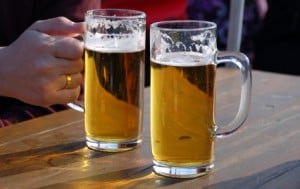 Blonde Ale is a light, slightly malty beer popularized by the American craft beer movement. This week we take a look at the history of Blonde ale, how to brew it at home and some recipes.
Blonde Ale is a light, slightly malty beer popularized by the American craft beer movement. This week we take a look at the history of Blonde ale, how to brew it at home and some recipes.
History of Blonde Ales
It is difficult to trace the precise origin of the term “Blonde Ale”, but it is clear that Blonde Ales are a modern style. The American Blonde Ale style is largely an invention of the US craft beer revolution of the early 1990’s. In the UK, John Gilbert of Hop Back Brewery is widely credited with developing a Blonde ale called “Summer Lightning in 1989. Blonde ales are now widely made in Belgium (such as Duval), the UK, US, Brazil, France, and indeed worldwide.
The style itself has heritage back to both Pale ales and light European ales such as Kolsch, both of which have been produced for centuries. Significant variations exist, with West Coast US breweries often pushing the more assertive Pale Ale end of the spectrum,while others explore moderate English summer ales or the light Kolsch end of the flavor spectrum.
The Blonde Ale Style
Blonde ales are light in color and generally have a malty aroma. Some variations have a slight hop aroma as well reflecting the hop variety chosen, but the flavor balance should be towards the malty side. They generally are light yellow to gold in color, clear, and brewed with moderate carbonation. Some variants such as the English may have a slight fruitiness, but they should not have diacytl or harsh bitterness. Some also have a slight toasted malt flavor (biscuit, bread, toast, or wheat) but they should not have any caramel or roasted flavors.
The style is brewed to a moderate alcohol level of 3.8-5.5%, with an original gravity of 1.038-1.054. Color is light – generally 3-6 SRM and the beer is hopped to provide a slightly malty finish – with only 15-28 IBUs. Blonde ales should have a clean finish and be very drinkable.
Brewing a Blonde Ale
Blonde ales are traditionally brewed as an all malt beer, though some examples do use up to 25% wheat malt or sugar adjuncts to lighten the beer. Many are made with 100% pale malt. Cara-Pils/Dextrine malt is often added for head retention. Caramel/Crystal malt is used only to add color, and generally only the lightest variants (10-15L) as a caramel flavor is not desired. Some brewers do add small quantities of Munich, Vienna, Biscuit or lightly toasted malt to enhance either the malty or toasted/biscuit flavor. Fruit variants of Blonde are also popular (Strawberry Blonde for example) since the light palette of a blonde goes well with many fruits.
Just about any hop variety can be used in a Blonde ale. American Blonde’s obviously trend towards American hop varieties, but excellent Blonde ale can be made with English, Continental and New Zealand/Australian hop varieties as well. Some care needs to be taken with stronger/harsher hop varieties to maintain the balance of the beer as it should always tilt slightly towards the malty side without excessive hop flavor or aroma. Some brewers select lower alpha/moderate hop varieties for this reason.
Since a clean finish is desired, most brewers use a well attenuating yeast such as California Ale yeast (WLP001) or American Ale yeast. Some brewers also favor Kolsch ale yeast for its clean light finish. Other possible yeast choices include Belgian Ale yeast or English ale yeast, but care should be taken to maintain a relatively clean finish with no diacytl.
For all grain brewers, a light body mash profile (148F/64C) is appropriate. Extract brewers should pick a light colored malt and take care to avoid carmelization during the boil. Blonde ales are fermented and aged at typical ale temperatures, and sometimes filtered or cold stored for a period to enhance clarity. The beer is moderately carbonated, and should have a long lasting white head.
Blonde Ale Recipes
Here are some of the top rated Blonde Ale recipes from our BeerSmithRecipes.com sharing site:
I hope you enjoy brewing your own Blonde Ale at home. Thanks for joining me on the BeerSmith Home Brewing Blog. Please subscribe to my newsletter for weekly articles on brewing techniques and beer styles, and also check out my podcast on beer brewing which is also available on iTunes.
Earlier this week I interviewed a woman who’s a microbiologist by day and has recently become a brew master at night. Her first try was a Belgian Ale – http://www.tinseltine.com/2013/03/home-brewing-with-melissa.html
The longer I brew, the lighter/less hoppy I seem to be wanting my beers. I was big into the Stouts years ago but now I want to brew things like these Blonde ales (plus they are gateway beers to my none homebrewing friends)
Pingback: Meet Kelly France: Brewer and Brainiac | BrewLife
I’m hearing of of beer being gluten-free. Are there any strange after tastes with these types of “healthier” beers?
My sons are interested in trying their hand at making English, Irish or Scottish Beer at home. I am interested in procuring recipes for them to try. They are 33 and 35 yrs old. We live on a farm and I have purchased 10 hops plants to plant for their enjoyment. Thanks
Blond ale is aperfect stile for Summer